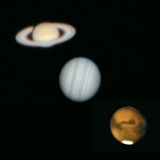Jupiter is the largest planet in our solar system. It is known as a "gas giant" because it is almost entirely made of gas and has no solid surface. All we ever see of Jupiter is the topmost layers of the clouds that make up its very thick atmosphere. Jupiter rotates very rapidly, spinning faster than once every ten hours, which forces the clouds into prominent horizontal bands: the darker ones called belts and the lighter ones called zones.
 Cylindrical projection of Jupiter's upper atmosphere. Credit: NASA
Cylindrical projection of Jupiter's upper atmosphere. Credit: NASA
Everything we see on Jupiter is activity in Jupiter's upper atmosphere, and is unconnected to anything on Jupiter's surface (such as it is). Even the largest and most striking feature in Jupiter's atmosphere, the gigantic anticyclone known as the Great Red Spot, is strictly an atmospheric phenomenon, unconnected to anything below it. This is shown by the fact that the Red Spot has drifted back and forth in longitude over the many years it has been observed.
The Great Red Spot was discovered by Giovanni Dominico Cassini in 1665, and has been observed by astronomers ever since: 341 years is a remarkably long lifetime for a weather system! Over the centuries, aside from drifting back and forth in longitude, it has varied greatly in size, color, and visibility. In some years it has been brick red and extremely obvious, but most of the time it varies between pale yellow and salmon color. In recent years, it has become very pale, but this year its visibility has been enhanced by having a dark festoon enclose its southern border, outlining it as if by a thin ink line. I have observed it over the past few weeks in a variety of telescopes, some as small as 85mm aperture, so this is a good year to look for it.
Spot the Spot
The main trick in spotting the Red Spot is to be looking at the right side of the planet! If you just look at random, you have about a one in four chance of seeing it, because it's only visible when within about 45° of the midline of Jupiter's disk, know as the central meridian. To increase your odds, you can use Starry NightŪ to predict when it will be well placed.
Because the Red Spot drifts in longitude, Starry NightŪ may not show it in its proper position. To ensure the Red Spot is in the proper position, download the latest files by selecting LiveSky-Update Comets/Asteroids/Satellites from the main menu in Starry NightŪ.
You can also do this manually by editing a text file which contains the Red Spot's longitude: JupiterGRS.txt. In Windows, the default path is:
- C:/Program Files/Starry NightŪ
/Sky Data/JupiterGRS.txt
On the Macintosh, the file is located inside the Starry NightŪ application file. Locate the Starry NightŪ application file under Applications inside the Starry NightŪ folder, where it will be called "Starry Night
- Contents/Resources/Sky Data/JupiterGRS.txt
Once you find the file JupiterGRS.txt, open it and replace whatever number is in the last line in the file with "109.0" (no quotation marks!)
This number comes from an article on Sky & Telescope's Web site, where the longitude of the Red Spot is kept up to date:
Transit Times of Jupiter's Great Red Spot
With the correct longitude in place, Starry NightŪ will show the Great Red Spot in its correct position, making it easier to decide when to observe. Unless you're observing with quite a large telescope, don't expect to see much color in the Spot, if any. Look for the indentation it makes in the dark southern edge of the South Equatorial Belt, and the hairline that divides it from the light South Tropical Zone to the south.
 Jupiter's belts and zones. Credit: Geoff Gaherty.
Jupiter's belts and zones. Credit: Geoff Gaherty.
Red Jr.
In February of this year, amateur astronomer Christopher Go in the Philippines noticed that the normally white oval "BA" in the South Temperate Belt had developed a distinct red color, similar to that of the Great Red Spot. Tony Phillips of NASA nicknamed it "Red Jr." It is a much smaller object than the Great Red Spot, less than half its size, and so much harder to see in small telescopes. I have observed it in my 11 inch Newtonian as a whiter patch within the darker STB, but saw no color.
At present Red Jr. is following its larger namesake around the planet and is slowly catching up with it. When I observed it on May 30, it was trailing Big Red by 35 minutes, but that time difference will be less by the time you read this. Look for a small light area in the belt immediately to the south of the Great Red Spot. Since the two spots are at different latitudes, they should pass each other comfortably, but there may be some interaction between their opposing currents.
Red Jr. in Starry NightŪ
I've had several questions lately asking whether Red Jr. is visible in Starry NightŪ. Because of Jupiter's rapid rotation, its atmosphere is subject to extreme and rapid change. The image of Jupiter's cloud tops in Starry NightŪ was prepared several years ago, and so doesn't reflect recent changes in Jupiter's atmosphere. A new image produced from current images would be obsolete within a few days because of the strong east-west currents.
The various surface features depicted in the Starry NightŪ Jupiter image are accurate _generic_ depictions of typical Jovian cloud features, but cannot be used to predict the actual appearance on a given night, with the one exception of the Great Red Spot, always assuming your JupiterGRS.txt file contains the correct current longitude of the Spot, as described above. For the latest depictions of the Great Red Spot and Little Red, check out the images on Christopher Go's Red Jr. Web site:
Good luck in spotting the Red Spots, Great and Jr.!
July 2006
Geoff has been a life-long telescope addict, and is active in many areas of visual observation; he is a moderator of the Yahoo "Talking Telescopes" group.


















